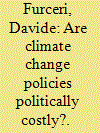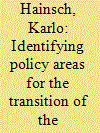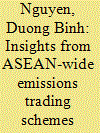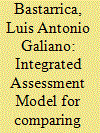|
|
|
Sort Order |
|
|
|
Items / Page
|
|
|
|
|
|
|
| Srl | Item |
| 1 |
ID:
191286


|
|
|
|
|
| Summary/Abstract |
Are policies designed to avert climate change (Climate Change Policies, or CCPs) politically costly? Using data on governmental popular support and the OECD's Environmental Stringency Index covering 30 countries between 2001 and 2015, our results show that CCPs are not necessarily politically costly: policy design matters. First, in contrast to non-market-based CCPs (such as emission limits), only market-based CCPs (such as emission taxes) entail political costs for the government. Second, the effects are only present when CCPs are adopted during periods of high oil prices, prior to elections, or in countries depending strongly on non-green (dirty) energy sources. Third, CCPs are only politically costly when inequality is high and/or social insurance/transfer does not sufficiently address the regressivity of CCPs. Our results are robust to numerous robustness checks including to address concerns related to endogeneity issues.
|
|
|
|
|
|
|
|
|
|
|
|
|
|
|
|
| 2 |
ID:
191306


|
|
|
|
|
| Summary/Abstract |
Climate change received substantial attention because of its implications on all spheres of life. This study examined the effects of climate change mitigation on the economic, environmental, and social development of 18 European countries based on the environmental performance index for data from 1981 to 2018; control variables include foreign direct investment, trade openness, renewable and non-renewable energy, population growth and life expectancy. Panel quantile regression result shows that climate change mitigation is ineffective in promoting economic growth in an aggregate manner; only high and moderate environmental performance ranking countries manage to spur economic growth and social development. Low environmental performance rankings countries reveal no impact of climate change mitigation. Climate change mitigation promotes environmental development for all countries. Trade openness and energy choices are crucial to ensure climate change mitigation efforts. Findings indicate that the European Union needs well-designed strict policies that emphasize and help countries increase the share of renewable energy compared to fossil fuels and promote the integration of climate mitigation technology at the national and regional level through lenient tariffs, subsidization, financial aid, and technical assistance that help low economic growth countries accelerate the transition that is required to achieve overall economic, social, and environmental goals.
|
|
|
|
|
|
|
|
|
|
|
|
|
|
|
|
| 3 |
ID:
191307


|
|
|
|
|
| Summary/Abstract |
Carbon emissions trading schemes (ETS) are critical environmental regulation policies that can reduce regional CO2 emissions and promote innovation. China's carbon ETS, applied at the city level, has yet to be studied for its effects on technology transfer. We investigate how carbon ETS affects technology transfer in China's prefecture-level cities using the difference in differences (DID) method. The results show that compared to the control group, technology transfer strength in the treatment group increased by 0.185 units on average. There are two directions in which technology transfer strength can be significantly increased: in-strength and out-strength. In addition, we find that carbon ETS can greatly promote technology transfer cross provinces. Furthermore, we explored the heterogeneous effects of city scale and innovation environment on technology transfer. The carbon ETS also promotes more significant effects on technology transfer in big cities. A city with a low innovation environment is not conducive to promoting technology transfer in comparison with a city with a good innovation environment.
|
|
|
|
|
|
|
|
|
|
|
|
|
|
|
|
| 4 |
ID:
191284


|
|
|
|
|
| Summary/Abstract |
In this paper we investigate the relationship between increasing shares of renewable generation and the wholesale market revenues of coal-fired generating units in Australia's National Electricity Market (NEM). Renewable generation may influence coal generator revenues both through decreased spot market prices and reduced dispatch allocation. We use autoregressive distributed lag (ARDL) models on a high-frequency (30-min) panel dataset between July 2017 and June 2021. We find that a one MWh increase in wind and solar generation each is associated with decreases in coal generator revenues of 0.0062–0.0083 and 0.0041 to 0.0054 AUD2012 respectively, per megawatt of installed coal-fired generating capacity. These results can inform managerial and policy decisions regarding the likelihood of more premature coal plant exits in the coming decades.
|
|
|
|
|
|
|
|
|
|
|
|
|
|
|
|
| 5 |
ID:
191299


|
|
|
|
|
| Summary/Abstract |
The setting of China's peaking target by 2030 for total CO2 emissions places stricter requirements on low-carbon production in each province. The allowable CO2 emissions will become a limited resource in the future which need to be allocated properly. In this paper, a multi-objective optimization method is used to realize the continuous allocation of carbon emission quota (CEQ) of each province from 2020 to 2030 under two different peaking paths by comprehensively considering three objectives of cost, efficiency, and fairness. In addition, the 30 provinces are divided into 4 groups and the distribution results were compared within and between groups. The results show that: (1) provinces with larger historical carbon emissions will be allocated more CEQ, while provinces with smaller carbon emissions will achieve peak carbon earlier, and the key to controlling total carbon emissions lies in the five provinces (Guangdong, Hebei, Henan, Jiangsu, Shandong) in Group 2; (2) the peak scenario and CEQ allocation scheme corresponding to path 2 will be more consistent with the future development requirements of China's energy, economy and environment; (3) Multi-objective is necessary and the continuous CEQ allocation scheme will be significant for guiding provinces to arrange future annual production plan.
|
|
|
|
|
|
|
|
|
|
|
|
|
|
|
|
| 6 |
ID:
191304


|
|
|
|
|
| Summary/Abstract |
Triggering a massive wave of renovation in buildings and sustaining it over the long term requires a mix of policy instruments ranging from regulations, renovation incentives, and financial models. In this context, an innovative financing approach to consider is Pay-for-Performance (P4P) programmes, which use data-driven measurement and verification approaches and engage both energy and third-party service providers in energy efficiency projects. However, while in North America, several energy utilities have already piloted and launched energy efficiency P4P programmes, progress in the European Union (EU) still remains slow. In this article, we focus on how the existing EU regulatory and market framework could support the deployment of P4P programmes. To do so, we combine a Strengths, Weaknesses, Opportunities, and Threats framework with an Analytical Hierarchy Process method and a Threats, Opportunities, Weaknesses, and Strengths matrix for the analysis of different stakeholder perceptions and the formulation of policy strategies. Policy recommendations include, among others, establishing demanding energy performance standards, valuing energy efficiency as a resource, and promoting “metered savings” methodologies. Overall, our work serves as a reference point for policy developments and adjustments that could facilitate the design and deployment of performance-based energy efficiency programmes in the EU.
|
|
|
|
|
|
|
|
|
|
|
|
|
|
|
|
| 7 |
ID:
191290


|
|
|
|
|
| Summary/Abstract |
Energy efficiency is “the first fuel” due to its abundant availability and low cost in terms of supply, based on the IEA. The primary energy intensity was often employed to measure energy efficiency. Among 46 countries, the improvement of energy efficiency from 2000 to 2020 ranged between 61.54% and −3.16%, suggesting the situation and influence factors of energy efficiency may be different across countries. To systematically find the drivers and barriers of energy efficiency, panel regression models were built. The variation of energy efficiency can be explained by not only the traditional GDP and structure effects in the decomposition methods, but also the weather, trade, and infrastructure effects. For the heterogeneous countries, the average performer, instead of the best one in the data envelopment analysis, was compared. Estimated results indicated that key drivers of energy efficiency were the growth of GDP, increases of renewable energy, and electrification. The global warming decreased heating degree days and increased cooling degree days, causing the climate factors partially offset each other. Other factors of the energy efficiency improvement included the industrial transformation, trade openness, and increasing population. These influences were different across countries; thus, the country-specific routes of energy efficiency improvement were found.
|
|
|
|
|
|
|
|
|
|
|
|
|
|
|
|
| 8 |
ID:
191288


|
|
|
|
|
| Summary/Abstract |
Researchers have speculated that limited participation in low-income energy efficiency programs is due, in part, to poor communication of program information. In response, we modified Bamberg’s stage-based model of behavior change (SSBC) to understand decision-making amongst low-income residents regarding residential energy efficiency programs. We then used the model to develop a framework for creating more informative communications. As a test of the framework, we redesigned web pages describing low-income energy efficiency programs in accordance with the framework and examined the effect of the change by randomly assigning low-income survey participants (
) to an original or redesigned version of the web page for three electric distribution companies. We found that redesigning these web pages directly, or indirectly, via mediation from likeability of a web page, improved low-income respondents’ assessment of program eligibility; increased their ratings of the importance and value of program outcomes; and increased their intentions to apply for and complete the program. The results signify the legitimacy of the framework as a method for reducing barriers to participation in energy efficiency programs, thereby having practical implications for the organizations and policymakers seeking to increase involvement in these programs. We discuss predictors of application intentions and implications for program communications.
|
|
|
|
|
|
|
|
|
|
|
|
|
|
|
|
| 9 |
ID:
191282


|
|
|
|
|
| Summary/Abstract |
The present study empirically tests the adoption of hydrogen fuel cell vehicles (HFCV) through the role of attitudes, perceptions, environmental concerns, and the effect of policy implications. An online survey was conducted among Indians who are knowledgeable and aware of HFCV developments in the country. A multi-stage stratified sampling technique was used to acquire the data. The paper examined a postulated model using structural equation modelling. The findings of this research confirms that motivation and knowledge sharing had a significant effect on attitude toward HFCV adoption. Potential adopters perceived that risk, cost, and infrastructure significantly impact HFCV adoption. In addition, the research indicates that stakeholders may influence buyer attitudes through suitable government policy and coordinated affirmative actions, including incentives for HFCV manufacturers, refuelling stations, HFCV buyers, and infrastructure developers. The infrastructure developers need viability gap funding to address the financial constraints and create enabling eco-system for a higher HFCV adoption.
|
|
|
|
|
|
|
|
|
|
|
|
|
|
|
|
| 10 |
ID:
191295


|
|
|
|
|
| Summary/Abstract |
Energy Performance Certificates (EPCs) are designed to provide consistent and comparable energy efficiency ratings. Since 2008, any building constructed, rented or sold is required to obtain an EPC in the UK. 4% of simple office buildings have renewed their EPC to date in England and Wales. In this paper, by comparing the original and renewed EPCs of these buildings, we examine the reliability of non-domestic EPC ratings and discover realistic energy efficiency improvement strategies reflected in the changes. We have found that buildings with their conditions remaining unchanged can be better rated by approximately 10 points on average when their initial rating is above the minimum requirement in the regulation. The ones initially rated below the minimum requirement are expected to have a greater scale of improvement on ratings while making no efforts which brings doubts on the effect of the “Minimum Energy Efficiency Standard” policy. Evidenced human factors are also jeopardising the fairness of EPC ratings. Based on the changes in the EPCs, we have found 4 clusters of improved buildings and 5 clusters of deteriorated buildings. We derived practical energy efficiency improvement strategies that people have already naturally adopted.
|
|
|
|
|
|
|
|
|
|
|
|
|
|
|
|
| 11 |
ID:
191291


|
|
|
|
|
| Summary/Abstract |
It is widely acknowledged that the servitisation of energy retail has the potential to reduce costs and environmental impact. However, there persists a limited awareness of what market activities the energy service concept can translate into, especially in Smart Local Energy Systems (SLES). In this paper an analytical framework is developed, tested, and applied to help clarify the energy service concept, assess where its application is most appropriate in such systems, and facilitate a more strategic approach to value creation at both household and systems level to support the transition to net zero. First, we develop it through a content analysis of the energy service field's most cited papers. Second, we test its boundaries at household level through a round of interviews. Third, we demonstrate its relevance at the energy systems level by applying it in two SLES contexts. Its application revealed that focusing on value creation through material-centric energy services alone is unviable while their coordinated integration into SLES involving centralised data-centric activities creates a potential business case around network reinforcement savings and flexibility provision. For the energy service concept to succeed in the residential sector, contractual service offerings require place-based energy system integration to align with network characteristics.
|
|
|
|
|
|
|
|
|
|
|
|
|
|
|
|
| 12 |
ID:
191292


|
|
|
|
|
| Summary/Abstract |
Due to the severity of climate change, the Chinese government has committed to the carbon neutrality target. Winter heating is a major source of carbon emissions in northern China, and it is urgent to promote the adoption of clean heating in northern rural areas. With indoor-survey data, both two-stage regression and structural equation modeling were used in this study to figure out the exact driving factors and causal relationships of rural households' energy choices considering subjective factors that may influence the energy choices and willingness to pay. Results contradict the energy ladder hypothesis and conclude that it might be caused by energy consumption habits and fuel stacking strategy. Both demographic characteristics and education level have a significant effect on heating energy choices. As for residents' willingness to pay for clean heating, it shows that households’ environmental perceptions, socioeconomic status, and demand for policy subsidies play an important role. Our results make a strong case for policies that shape residents' low-carbon values, promote technological innovation in clean energy, and set reasonable subsidies for clean heating to encourage a clean heating transition.
|
|
|
|
|
|
|
|
|
|
|
|
|
|
|
|
| 13 |
ID:
191283


|
|
|
|
|
| Summary/Abstract |
Being the only energy sector where emissions are still at 1990 levels, the German transportation sector requires rapid decarbonization to achieve ambitious climate targets. Policy makers need to put the framework in place which enables and supports this transition. This work analyzes which policy areas should be targeted considering interactions with and implications for the entire energy system. The Global Energy System Model (GENeSYS-MOD) is used to compute 400 sensitivities which showcase the effectiveness of specific transport and energy system related policies. Shifting transportation demand to less energy and emission intensive modes or avoiding it in the first place shows the strongest effect on a number of key metrics. Primary energy consumption, emissions, and fleet size can all be reduced through a combination of electrification and shift towards public transport and long-distance trains. Carbon prices also showcase significant effects while further affecting the other energy sectors. The results suggest that in the intermediate term, modal shift and demand reduction can help with reducing transportation related emissions, while carbon prices are effective after 2040.
|
|
|
|
|
|
|
|
|
|
|
|
|
|
|
|
| 14 |
ID:
191293


|
|
|
|
|
| Summary/Abstract |
In the midst of the energy crisis being felt throughout many parts of Europe, this study aims to investigate the full impact of Austria’s 2002 continent-leading climate strategy on national renewable energy consumption. We use country level OECD data spanning 1990–2015 and the synthetic control method. We find that compared to other countries, Austria’s renewable energy consumption rose between 2.64% and 4.43% per annum following the policy. Contrary to some concerns, we do not find that per capita output fell significantly with the greater adoption of renewable energy sources. The study contributes to the literature on environmental governance, policy discourse, and climate. It also provides critical policy insights in the roadmap toward energy security for other countries transitioning toward renewable sources. Results suggest that policies that incentivize renewable energy adoption can meet long term environmental targets without having an adverse impact on economic growth.
|
|
|
|
|
|
|
|
|
|
|
|
|
|
|
|
| 15 |
ID:
191302


|
|
|
|
|
| Summary/Abstract |
Africa is short of power, despite having abundant renewable energy resources. Over the past decade, renewable energy auctions have emerged as an effective mechanism to competitively procure utility-scale private power projects. This paper identifies the elements contributing to efficient price and effective project realisation outcomes through comparative case studies in South Africa, Zambia and Namibia. The analysis combined existing literature and theory on those elements that contribute to success in Independent Power Projects (IPPs), with that on renewable energy auction design and implementation. The application of an integrated analytical framework shows that the introduction of renewable energy auctions in Africa provides an essential programmatic element which connects existing country and project level factors and is crucial in achieving superior project realisation and price outcomes, compared to projects procured through direct negotiation or feed-in tariffs.
|
|
|
|
|
|
|
|
|
|
|
|
|
|
|
|
| 16 |
ID:
191281


|
|
|
|
|
| Summary/Abstract |
Given China's severely separated renewable energy (RE) supply area and load area, the power transmission capacity across regions restricts RE penetration and is directly affected by RE-related support policies. Thus, a multi-objective optimization model is developed to explore the impacts of changes in renewable portfolio standard (RPS) and feed-in tariff (FIT) policies on the optimal transmission line layout. The model regards the maximization of RE power grid-on and minimization of the total cost for the optimal line layout, transmission capacity, and technology selection. We found that power transmission in "West-to-East" and "North-to-South" is strengthened, with the capacity expected to expand 2.2 times between 2020 and 2040. 2024–2026 is the period with the most new lines. The new line grows when the RPS target increase. Compared with the business-as-usual scenario, in the two scenarios where RPS increased by 10% and 15%, the newly built lines' number could grow by 35% and 21%, respectively. On the contrary, if the FIT subsidy continues beyond 2020, the demand for new line construction may decrease, reducing 480 TWh (FIT2025) and 330 TWh (FIT2040) of RE power on-grid. Further, the penetration proportion of renewable generation could be 55.8%–61.8% in 2040, achieving high penetration of RE in China.
|
|
|
|
|
|
|
|
|
|
|
|
|
|
|
|
| 17 |
ID:
191300


|
|
|
|
|
| Summary/Abstract |
ASEAN has not yet had any joint policy to constrain emission levels in the context of global efforts to tackle climate change and studies on such issues in the region are still scarce. This study employs a global computable general equilibrium (CGE) climate change policy-focused and electricity-detailed model to examine the impacts of emissions trading schemes (ETSs) on the ASEAN member economies. We found that Indonesia (a permit buyer) experiences much lower economic costs in the regional ETS scenarios rather than in its closed ETS market (−9% compared to −16% in real GDP). Malaysia, the Philippines, Singapore, Thailand and Vietnam act as permit sellers and experience higher economic costs in the regional ETS scenarios. It is because the balance on the current account, which is equal to the sum of the ordinary trade balance and net emissions trading revenue, is assumed to be fixed. Furthermore, the change in ratio of trade balance to regional income is also fixed. Such a setting indicates that if the net permit trading revenue is used to fully compensate for the trade balance, which is also maintained along with the changes in the regional income, permit selling countries will be worse off and vice versa if they move from their domestic ETS markets into a regional ETS market. Results also show that technological improvements can help reduce economic costs of the ETSs. In addition, renewable energy sources show strong expansions in their production levels, but they are still far from becoming dominant in ASEAN in order to significantly reduce economic costs of climate change policies. Households will also increase their demand for renewable energy in all ASEAN countries while lowering demand for fossil-based energy; however, this sector will still experience reductions in the overall electricity demand due to previous strong reliance on fossil-based energy.
|
|
|
|
|
|
|
|
|
|
|
|
|
|
|
|
| 18 |
ID:
191298


|
|
|
|
|
| Summary/Abstract |
The decarbonisation of electricity supply poses a major milestone in the mitigation of climate change. Integrated Assessment Models (IAMs) provide a relevant instrument for the quantification and comparison of the economic and environmental impacts of various electricity decarbonisation scenarios, despite having rarely been applied to a national context. In this paper, an IAM able to calculate such impacts on the electricity sector in Spain is presented. Developed using the latest IAM modelling literature, the proposed model is able to estimate changes in temperature, climate-induced economic losses, and investment needs for climate mitigation corresponding to a range of electricity decarbonisation scenarios on a time horizon to 2050. The findings show that scenarios that undertake deeper and earlier cuts in CO2 emissions from electricity generation would achieve better welfare results, and that further reliance on fossil fuels would imply higher costs than the investment needed for renewable energy deployment in Spain. The findings constitute an insight towards the formulation of policies that address the decarbonisation of the Spanish electricity supply.
|
|
|
|
|
|
|
|
|
|
|
|
|
|
|
|
| 19 |
ID:
191294


|
|
|
|
|
| Summary/Abstract |
Transport pricing (TP) can be a helpful policy instrument for climate action to reduce greenhouse gas emissions and foster sustainable mobility. Yet few cities have implemented TP. The main barriers include a lack of public and political acceptance, especially in regions with entrenched socio-technical systems and cultures of automobility. The dominance of automobility can be a reason for TP to be unacceptable to the public and politicians. Yet, policies for low-carbon mobility may ultimately fail if they are designed within automobility. This article considers this tension in transport-pricing policy design, as a subset of broader climate policies. How can public acceptance be secured for TP, both navigating within automobility to gain sufficient public uptake but also beyond automobility towards more transformative climate action? This paper examines the proposed TP policy for Vancouver, Canada. We summarize what has been found to support public and political acceptance of TP in other cities, and then particularly look at Oslo, Norway. Our findings suggest that TP policy-design that parts with an automobility regime—and rather is carried out within a low-carbon paradigm—may confront greater short-term challenges with public acceptance, but will better position such an innovative policy for success on the long-term.
|
|
|
|
|
|
|
|
|
|
|
|
|
|
|
|
| 20 |
ID:
191305


|
|
|
|
|
| Summary/Abstract |
Much has been written on the rooftop solar photovoltaic (PV) adoption in the U.S., but granular economic assessment at large scale is missing. We provide household level PV economic assessment for a medium size city in North Central Florida, and analyze the economic viability of these installations. Results show that a large number of households will not benefit from solar installations. Further, economic viability is heavily reliant on incentives whose future is uncertain at best. Our analysis did not reveal significant variations in economic viability across different household values — a proxy we used to differentiate household wealth. Yet, building permits and installation locations indicate economically disadvantaged communities have much lower installation rates as has been the main conclusion in the earlier literature. We argue economic assessment for PV should extend beyond simple benefit–cost analysis. A more nuanced approach should be taken in PV feasibility assessment, and structuring incentive schemes.
|
|
|
|
|
|
|
|
|
|
|
|
|
|
|
|
|
|
|
|
|